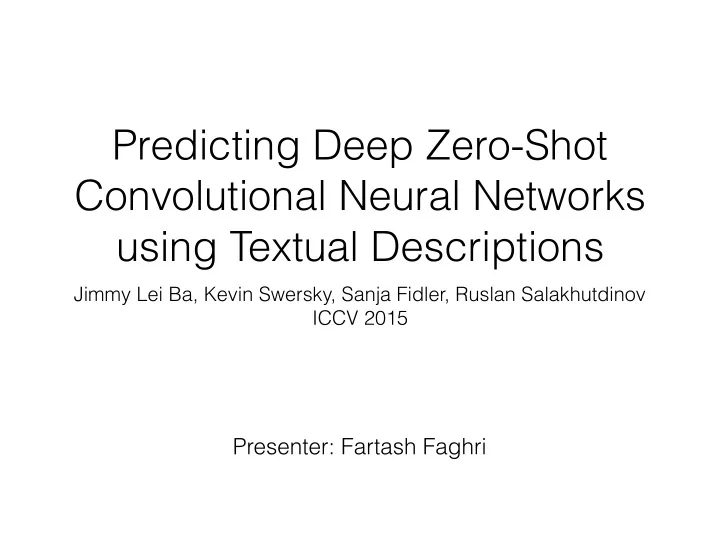

Predicting Deep Zero-Shot Convolutional Neural Networks using Textual Descriptions Jimmy Lei Ba, Kevin Swersky, Sanja Fidler, Ruslan Salakhutdinov ICCV 2015 Presenter: Fartash Faghri
Zero-shot Learning • Classify images of an unseen class given semantically or visually similar classes at training time. • Shared knowledge between Antol et al. [1] classes can be given in various forms, such as attributes or class descriptions.
Contributions • The main contribution is the convolutional classifier. The rest of the contributions are shared with [2]. • Predicts visual classes using text corpus, in particular, the encyclopedia corpus. This overcomes the difficulty of hand-crafted attributes. • The key difference with the most related work is that image and text features are transformed into a joint embedding space.
Classifier • Image feature vectors: • Text feature vectors: • A linear classifier: • Image transformation: • Text transformation:
Convolutional Classifier • Text can describe attributes (low) or objects (high). • Classifier on fully connected features: • Classifier on convolutional features: • Joint classifier: • is a global pooling function.
Learning • Binary Cross Entropy: • Hinge Loss: • Euclidean Distance between and
Loss Comparison Produced by WolframAlpha
Experiments • DA: the model is similar to the hinge loss form • DA+GP: in that model multiple text descriptions can be given for a class, GP part gives p(c|t), a prior. • fc baseline feat.: features from [2], HOG, GIST, etc • ROC: true positive rate vs false positive rate
Results
Results (cont.)
References • [1] Antol, Stanislaw, C. Lawrence Zitnick, and Devi Parikh. "Zero-shot learning via visual abstraction." European Conference on Computer Vision. Springer International Publishing, 2014. • [2] Elhoseiny, Mohamed, Babak Saleh, and Ahmed Elgammal. "Write a classifier: Zero-shot learning using purely textual descriptions." Proceedings of the IEEE International Conference on Computer Vision. 2013.
Recommend
More recommend